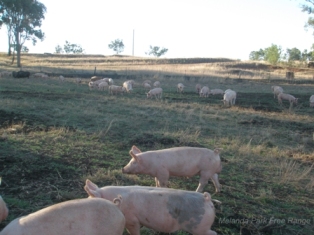So many people I speak to plan to start their free range farm with rare breed pigs, in particular, the Wessex Saddleback or English Large Black and some, the Berkshire.
What I stress to these people is the need to know the breed first. Make sure you understand the different characteristics of these pigs before you make a purchase and ensure that they are the right fit for your intended market.
Lets first briefly discuss the different attributes of the rare breeds, in fact, the very carcass characteristics that have seen their numbers reduce as their popularity waned and the commercial industry began favouring white breeds.
 |
The Wessex Saddleback and English Large Black would have to be the rarest of of the heritage breeds now that the Berkshire has once again gained some popularity. However, these three most recognisable breeds have the following in common:
-
Very fat pigs
-
Black hairs
-
Slow growing
So why am I telling you all this? There are three things that I believe attribute to the wonderful flavour of free range pork - fat, natural growth rates and the environment in which the pig lives.
Turning now to the commercial and white breeds of pigs. These are the faster growing, modern breeds most of which are white but do include a red breed, the Duroc. Without going into great depths on free range production and how to produce a marketable pig outdoors, most successful free range producers have found that they need to either use or incorporate these white breeds into their herds to meet general market specification so the question is often asked - which breeds taste better?
Any pork grown under a stress free and well managed free range and pasture based system will produce exceptionally flavoured and textured pork!
Without fat there is little flavour, without exercise there is little muscle tone or texture and without a clean, free range and pastured raised environment we will not have either.
Where to from here?
For further information on pig farming we recommend you purchase a Pig Farming Starter Kit which contains two popular pig farming books. Both books provide a practical guide to the pig husbandry, including health care, breeding programs for sows and raising piglets.
About the author
Lee McCosker - brings not only years of experience in farm animal welfare, but also a wealth of knowledge on free range farm operations, regulatory requirements and animal health and nutrition. After spending the last six years as farm animal welfare consultant to the Humane Society International, Lee's focus is now about a balanced approach to farm accreditation, one that encompasses the farmer, and the animals and nurtures both to ensure the best welfare for the animals but also the best outcomes for the producer and the consumer. Lee also runs the website Proof (Pasture Raised on Open Fields).



